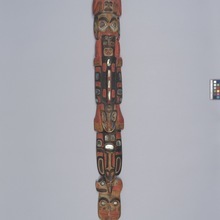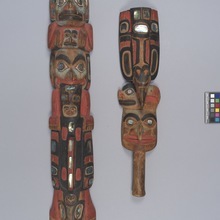Dance Wand
MOA: University of British Columbia
3260/106 a-b
Wooden song leader's staff or dance wand (wutsaagáa), cut into two pieces (parts a-b). At the bottom is a short, unpainted handle, otherwise the entire length is covered in carved figures depicting animals. Many abalone inlays have been used for eyes, and as decorative details on areas such as wings and fins. The figures are painted in red, black and light blue. The back is partially rounded/hollowed out. The two pieces have been attached by a long wooden peg, through a hole in each piece. (The peg now sits in the upper hole, visible at the back.)
-
Specific Techniques
Of the three paints used on the staff, the black and the bright red are probably commercial trade paints, while the blue-green is a mineral pigment that would have been ground up and mixed with water; it was applied in more protected areas of the carving.
-
Iconographic Meaning
Carved on the top two-thirds of this staff are figures replicating the Sea Creature interior house post, Gunakadeit Gaas, of the renowned Gaanax.teidí Yáay Hít’, the Whale House of Klukwan, Alaska. It represents an episode from the adventures of the Raven and the sea creature Gunakadeit. At the top is Gunakadeit’s child, and a face with a recurved beak/nose between its paws; this part refers to the story of how Gunakadeit’s “Daughters of the Creek” became responsible for the yearly return of the salmon. Next is Gunakadeit himself, who holds a whale with its tail in his mouth; a woman is portrayed on the whale’s back and the Raven is trying to emerge from its blowhole. The lower portion of the staff has imagery not from the house posts, but depicting what may be a diving raven holding a small creature in its beak, and then a supernatural bird above the bottom handle.
-
History Of Use
Raising their long staffs overhead, song leaders among the Tlingit mark the rhythm and direct their clan’s or house group’s singers and dancers, each dressed in clan regalia, as they enter the potlatch or dance celebration. Some staffs (also called wands) are in the shape of fins or paddles, while others -- like this one -- are carved and painted in a style similar to house posts or totem poles, displaying ancestral crests that, like the songs themselves, are the property of clans.
-
Narrative
The identity of the staff’s carver -- an artist working later in the 19th century -- is not yet known. Originally this staff was one piece, but at some point in its journey from ceremonial use to becoming an art object for the collectors’ market it was cut into two and pegged together; the carved handle on the back, moreover, was removed, likely to accommodate hanging the piece on a wall.
- Type of Item wand
- Culture Tlingit
- Material spruce wood, abalone shell, paint
- Measurements height 48.5 cm, width 11.5 cm, depth 7.0 cm (part a) height 64.0 cm, width 12.5 cm, depth 8.0 cm (part b) height 113.0 cm, width 12.5 cm, depth 8.0 cm (overall)
- Previous Owner Elspeth McConnell
- Received from Elspeth McConnell
- Made in North America
- Creation Date between 1860 and 1870
- Ownership Date before August 12, 2017
- Acquisition Date on August 12, 2017
- Condition good
- Accession Number 3260/0106 a-b


